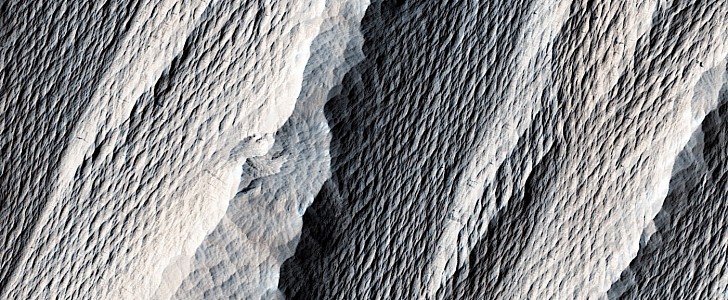We believe we pretty much understand what neighboring planet Mars is all about. Now dead and devoid of life, it might have once harbored it, thanks to the large amounts of liquid water it used to have.
But dead and devoid of life does not mean the place is a fully inert piece of rock. It still is geologically active and experiences marsquakes from time to time, and even if it doesn’t have a weather system or an atmosphere in the larger sense, it is capable of generating wind and, at times, planet-wide dust storms.
We know wind to be one of the driving forces behind planetary changes. Although it may not seem like it, given enough time and a steady direction, it even has the power to carve its way into rocks.
Wind does this not only on Earth, but where ever it is present. On Mars, we see the effects it has in the many images the HiRISE orbital camera has sent back over the years.
This one, captured in 2016 from an altitude of 271 km (168 miles), shows a portion of the Medusae Fossae region of the planet, riddled with strange patterns, apparent rhombi and squares spread over elongated hills and valleys.
The soil in this region is made of soft fine-grained rock, and this is why wind had little trouble in creating these shapes, which scientists call yardang – that would be protuberances created in bedrock by wind. For these to form, “wind direction would have dominated for a very long time,” NASA says, pointing to a past when Mars had somewhat stable such forces.
The absence of boulders and rubble makes the people studying Mars believe the area was formed by the cementing, over large periods of time, of “volcanic ash, atmospheric dust, or accumulations of wind deposited fine sands.”
We know wind to be one of the driving forces behind planetary changes. Although it may not seem like it, given enough time and a steady direction, it even has the power to carve its way into rocks.
Wind does this not only on Earth, but where ever it is present. On Mars, we see the effects it has in the many images the HiRISE orbital camera has sent back over the years.
This one, captured in 2016 from an altitude of 271 km (168 miles), shows a portion of the Medusae Fossae region of the planet, riddled with strange patterns, apparent rhombi and squares spread over elongated hills and valleys.
The soil in this region is made of soft fine-grained rock, and this is why wind had little trouble in creating these shapes, which scientists call yardang – that would be protuberances created in bedrock by wind. For these to form, “wind direction would have dominated for a very long time,” NASA says, pointing to a past when Mars had somewhat stable such forces.
The absence of boulders and rubble makes the people studying Mars believe the area was formed by the cementing, over large periods of time, of “volcanic ash, atmospheric dust, or accumulations of wind deposited fine sands.”






